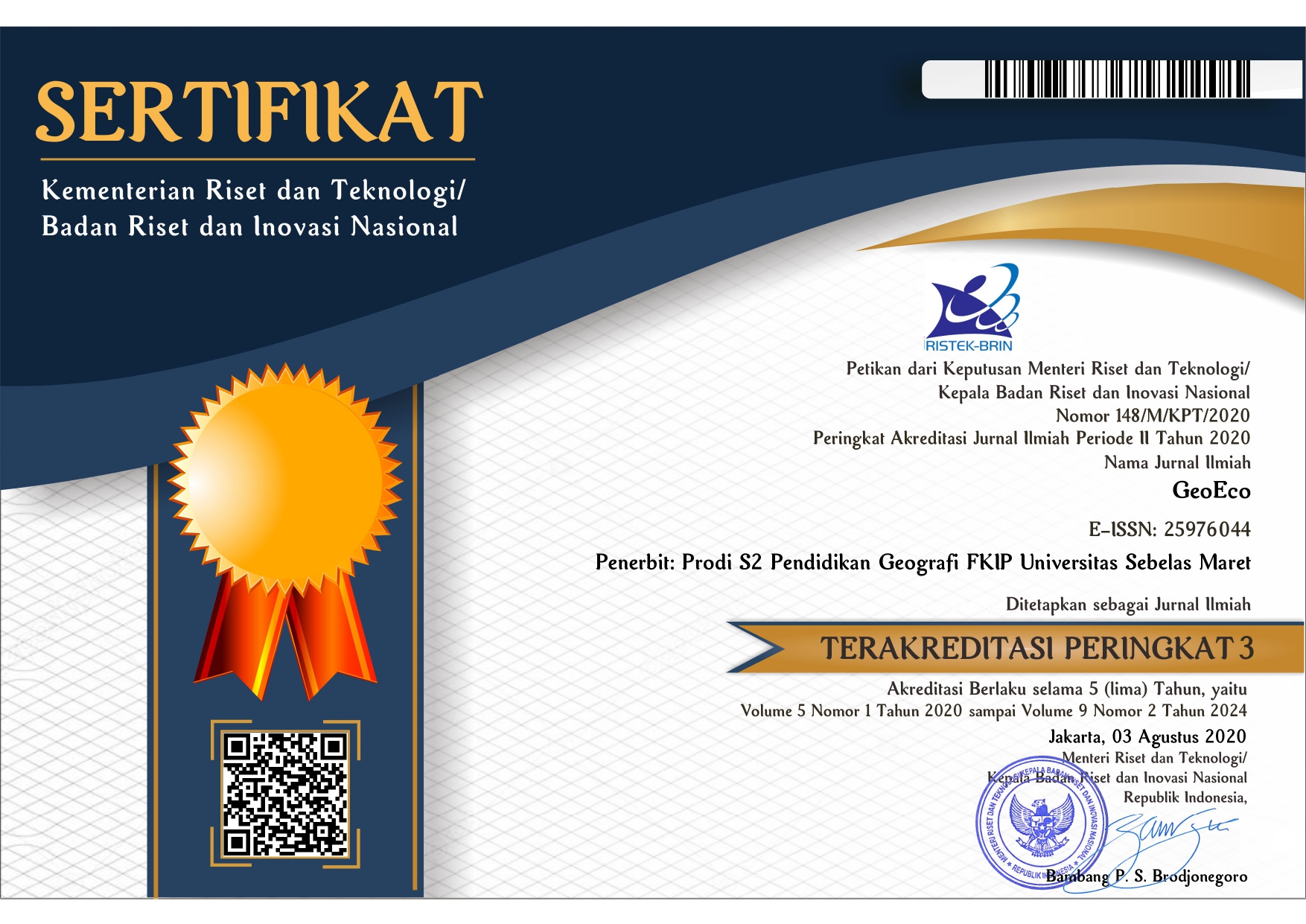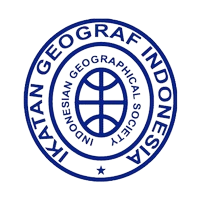SPATIAL DISTRIBUTION OF TOPONYMY IN KARST AREAS GIRITONTRO
Abstract
Keywords
Full Text:
PDFReferences
Ardanuy, M. C., & Sporleder, C. (2017). Toponym disambiguation in historical documents using semantic and geographic features. Proceedings of the 2nd International Conference on Digital Access to Textual Cultural Heritage, 175–180. https://doi.org/10.1145/3078081.3078099
Atik, M., Kanabakan, A., Ortaçeşme, V., & Yildirim, E. (2022). Tracing landscape characters through place names in rural Mediterranean. CATENA, 210, 105912. https://doi.org/10.1016/j.catena.2021.105912
Ayu Segara, N. B. (2017). JURNAL GEOGRAFI Media Pengembangan Ilmu dan Profesi Kegeografian KAJIAN NILAI PADA TOPONIMI DI WILAYAH KOTA CIREBON SEBAGAI POTENSI SUMBER BELAJAR GEOGRAFI Info Artikel (Vol. 14, Issue 1). http://journal.unnes.ac.id/sju/index.php/ujet
Azaryahu, M. (2011). The Critical Turn and Beyond: The Case of Commemorative Street Naming. ACME: An International E-Journal for Critical Geographies, 10(1), 28–33.
Budi Haryono, E., Madjid, A., & Trismadi. (2021). PENETAPAN TOPONIMI LAUT NATUNA UTARA OLEH INDONESIA TERHADAP KEAMANAN MARITIM DI WILAYAH LAUT CINA SELATAN. Jurnal Keamanan Maritim, 7(2), 181–201.
Capra, G. F., Ganga, A., Buondonno, A., Grilli, E., Gaviano, C., & Vacca, S. (2015a). Ethnopedology in the Study of Toponyms Connected to the Indigenous Knowledge on Soil Resource. PLOS ONE, 10(3), e0120240. https://doi.org/10.1371/journal.pone.0120240
Capra, G. F., Ganga, A., Buondonno, A., Grilli, E., Gaviano, C., & Vacca, S. (2015b). Ethnopedology in the Study of Toponyms Connected to the Indigenous Knowledge on Soil Resource. PLOS ONE, 10(3), e0120240. https://doi.org/10.1371/journal.pone.0120240
Conedera, M., Tinner, W., Neff, C., Meurer, M., Dickens, A. F., & Krebs, P. (2009). Reconstructing past fire regimes: methods, applications, and relevance to fire management and conservation. Quaternary Science Reviews, 28(5–6), 555–576. https://doi.org/10.1016/j.quascirev.2008.11.005
Conedera, M., Vassere, S., Neff, C., Meurer, M., & Krebs, P. (2007). Using toponymy to reconstruct past land use: a case study of ‘brüsáda’ (burn) in southern Switzerland. Journal of Historical Geography, 33(4), 729–748. https://doi.org/10.1016/j.jhg.2006.11.002
Cooper, C. (1993). Tourism: Principles & Practise. Longman Group Limited.
Corona, P., Quatrini, V., Schirru, M., Dettori, S., & Puletti, N. (2018). Towards the economic valuation of ecosystem production from cork oak forests in Sardinia (Italy). IForest - Biogeosciences and Forestry, 11(5), 660–667. https://doi.org/10.3832/ifor2558-011
Donald, B. J. (1987). Executive Secretary, United States Board on Geographic Names and Domestic Geographic Names First printing.
Fagúndez, J., & Izco, J. (2016). Diversity patterns of plant place names reveal connections with environmental and social factors. Applied Geography, 74, 23–29. https://doi.org/10.1016/j.apgeog.2016.06.012
Femenia-Ribera, C., Mora-Navarro, G., & Pérez, L. J. S. (2022). Evaluating the use of old cadastral maps. Land Use Policy, 114, 105984. https://doi.org/10.1016/j.landusepol.2022.105984
Fiorillo, F. (2009). Spring hydrographs as indicators of droughts in a karst environment. Journal of Hydrology, 373(3–4), 290–301. https://doi.org/10.1016/j.jhydrol.2009.04.034
Ford, D., & Williams, P. (2007). Karst Hydrogeology and Geomorphology. In Karst Hydrogeology and Geomorphology. https://doi.org/10.1002/9781118684986
Goldscheider, N., Chen, Z., Auler, A. S., Bakalowicz, M., Broda, S., Drew, D., Hartmann, J., Jiang, G., Moosdorf, N., Stevanovic, Z., & Veni, G. (2020). Global distribution of carbonate rocks and karst water resources. Hydrogeology Journal, 28(5), 1661–1677. https://doi.org/10.1007/s10040-020-02139-5
Jiang, Z., Lian, Y., & Qin, X. (2014). Rocky desertification in Southwest China: Impacts, causes, and restoration. Earth-Science Reviews, 132, 1–12. https://doi.org/10.1016/j.earscirev.2014.01.005
Jordan, P. (2012). Place Names As Ingredients of Space-Related Identity. Oslo Studies in Language, 4(2). https://doi.org/10.5617/osla.314
Kadmon, N. (2000). Toponymy: the lore, laws, and language of geographical names. Vantage Press.
Kavaratzis, M., & Ashworth, G. (2008). Place marketing: how did we get here and where are we going? Journal of Place Management and Development, 1(2), 150–165. https://doi.org/10.1108/17538330810889989
Kuzichkin, O. R., Romanov, R. V., Dorofeev, N. V., Vasilyev, G. S., & Grecheneva, A. V. (2021). Hydrogeological monitoring of karst activity based on regime observations in the territory of karst lakes. Journal of Water and Land Development, 48(1–3), 130–140. https://doi.org/10.24425/jwld.2021.136156
Luo, W., Hartmann, J., Wang, F., Pingwen, H., Sysamouth, V., Li, J., & Cang, X. (2017). GIS in Comparative-Historical Linguistics Research: Tai Languages. In Comprehensive Geographic Information Systems (Vol. 3, pp. 157–180). Elsevier Inc. https://doi.org/10.1016/B978-0-12-409548-9.09663-9
Monmonier, M. (2006). From Squaw Tit to Whorehouse Meadow. University of Chicago Press. https://doi.org/10.7208/chicago/9780226534640.001.0001
Parise, M., Gabrovsek, F., Kaufmann, G., & Ravbar, N. (2018). Recent advances in karst research: from theory to fieldwork and applications. Geological Society, London, Special Publications, 466(1), 1–24. https://doi.org/10.1144/SP466.26
Payne, R. L. (2001). Applied Toponymy in the United States. Names, 49(4), 293–299. https://doi.org/10.1179/nam.2001.49.4.293
Penko Seidl, N. (2008). Significance of Toponyms, with Emphasis on Field Names, for Studying Cultural Landscape. Acta Geographica Slovenica, 48(1), 33–56. https://doi.org/10.3986/AGS48102
Perdana, A., & Ostermann, F. (2018). A Citizen Science Approach for Collecting Toponyms. ISPRS International Journal of Geo-Information, 7(6), 222. https://doi.org/10.3390/ijgi7060222
Post, C. W., & Alderman, D. H. (2014). “Wiping New Berlin off the map”: Political economy and the de-Germanisation of the toponymic landscape in First World War USA. Area, 46(1), 83–91. https://doi.org/10.1111/area.12075
Radding, L., & Western, J. (2010). What’s in a Name? Linguistics, Geography, and Toponyms*. Geographical Review, 100(3), 394–412. https://doi.org/10.1111/j.1931-0846.2010.00043.x
Rais, J., Lauder, M. R. M. T., Sudjiman, P., Ayatrohaedi, S. B., Wiryaningsih, A., Suparwati, T., & Santoso, W. E. (n.d.). Toponimi Indonesia : Sejarah Budaya yang Panjang dari Permukiman Manusia dan Tertib Administrasi. PT. Pradnya Paramita.
Reinoso, A. S., & Tort, J. (2015). Toponyms as “landscape indicators.” BIBLIOTECA TÈCNICA DE POLÍTICA LINGÜÍSTICA, 1987–2016. https://doi.org/10.2436/15.8040.01.200
Rose-Redwood, R., & Alderman, D. (2011). Critical Interventions in Political Toponymy. ACME: An International E-Journal for Critical Geographies, 10(1), 1–6.
Rose-Redwood, R., Alderman, D., & Azaryahu, M. (2017). The urban streetscape as political cosmos. In The Political Life of Urban Streetscapes (pp. 1–24). Routledge. https://doi.org/10.4324/9781315554464-1
Ruspandi, J. (2016). FENOMENA GEOGRAFIS DI BALIK MAKNA TOPONIMI DI KOTA CIREBON. Jurnal Geografi Gea, 14(2). https://doi.org/10.17509/gea.v14i2.3394
Siderius, W., & de Bakker, H. (2003). Toponymy and soil nomenclature in the Netherlands. Geoderma, 111(3–4), 521–536. https://doi.org/10.1016/S0016-7061(02)00280-X
Stevanović, Z. (2018). Global distribution and use of water from karst aquifers. Geological Society, London, Special Publications, 466(1), 217–236. https://doi.org/10.1144/SP466.17
Stevanović, Z. (2019). Karst Aquifers in the Arid World of Africa and the Middle East: Sustainability or Humanity? (pp. 1–43). https://doi.org/10.1007/978-3-319-77368-1_1
Tichelaar, T. (2002). Toponymy and language.
Vuolteenaho, K., Koskinen, A., Kukkonen, M., Nieminen, R., Päivärinta, U., Moilanen, T., & Moilanen, E. (2009). Leptin Enhances Synthesis of Proinflammatory Mediators in Human Osteoarthritic Cartilage—Mediator Role of NO in Leptin-Induced PGE2, IL-6, and IL-8 Production. Mediators of Inflammation, 2009, 1–10. https://doi.org/10.1155/2009/345838
Wijayanti, P. (2020). Disaster Threats in the Gunungsewu Karst Area and Mitigation Efforts in the Framework of Disaster Risk Reduction Review of the Hydrological and Geomorphological Aspects. Social, Humanities, and Education Studies (SHEs): Conference Series Https://Jurnal.Uns.Ac.Id/Shes p-ISSN, 3(Smbpsb), 285–291.
Wijayanti, P., Muryani, C., Hidayati, F., Ronggowulan, L., & Zamani, M. Z. (2022). Community Capacity Bulding In The Kakap Spring Catchment Area. SHEs: Conference Series 5, 347–354. https://jurnal.uns.ac.id/shes
Wijayanti, P., & Noviani, R. (2021). Characteristics of Duwet Karst Spring Based on Baseflow Index Assessment and its Potential in Fresh Water Supply. GeoEco, 7(1), 38. https://doi.org/10.20961/ge.v7i1.45495
Zeng, C., Liu, Z., Yang, J., & Yang, R. (2015). A groundwater conceptual model and karst-related carbon sink for a glacierized alpine karst aquifer, Southwestern China. Journal of Hydrology, 529(P1), 120–133. https://doi.org/10.1016/j.jhydrol.2015.07.027
Refbacks
- There are currently no refbacks.












.png)

